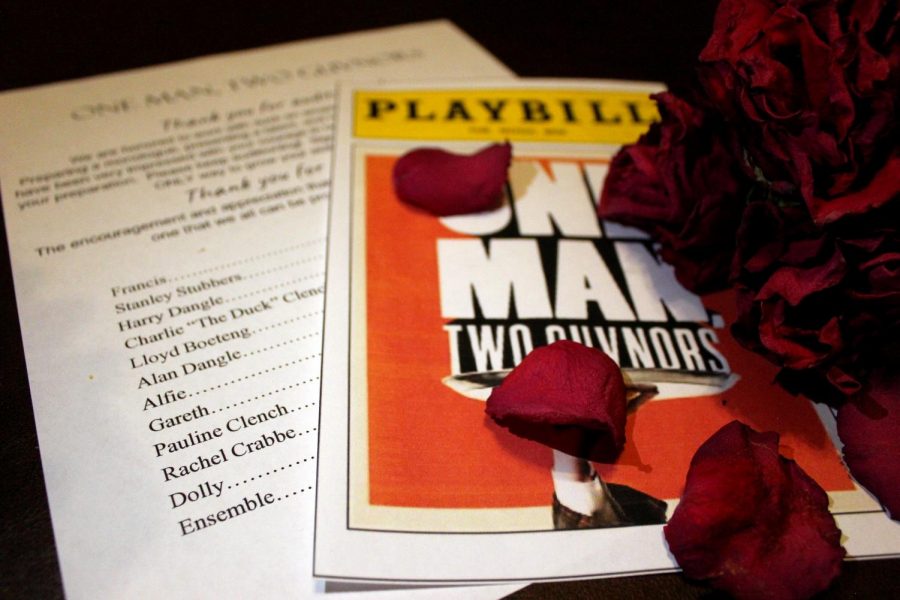The cast list for One Man, Two Guvnors has been released, meaning rehearsals can begin.
The cast list and what comes before it
As of Friday, February 8, the cast and crew for Fossil Ridge High School’s spring play, One Man, Two Guvnors, was finalized. While tech crew lists were released nearly two weeks prior, actors spent the past week performing monologues, reading dialects, and demonstrating any additional talents. The final cast list is as follows:
Francis…………Parker Bennett
Stanley Stubbers………..Austin Hand
Harry Dangle……….Tom Houser
Charlie “The Duck” Clench……….Lucas Feuer
Lloyd Boeteng……….Harrison Dachel
Alan Dangle……….Jack Kraus
Alfie………..Ben Ashby
Gareth……….Megan Bean
Pauline Clench……….Amelia Overholt
Rachel Crabbe……….Azelan Amundson
Dolly……….Olivia Zadković
Ensemble……….Ren Dunn, Orla McGrath, Connor Dalrymple, Jay Hirning, Matthew Coffey
However, while most of the school believes that play production begins with the initial crew decisions, it turns out that application, interview, and audition stages all have to occur before the play directors create these lists.
The week of January 14, applications became available for all tech positions. Simultaneously, sign-ups went up for audition times for actors. Applications included questions about why students wanted to be on the tech crews they listed and what skills they could bring to a production. All students who applied had to sign their applications in order to acknowledge the time commitment associated with the play.
Over the next few days, the call board began to display interview slots. Each student who applied for a tech position met with John Garner, one of several play directors and head of tech for the show, to answer further questions about the skills and dedication they could bring backstage. After those interviews were complete, students were invited for tech callbacks, which were held over several days in the Black Box.
Though someone might have wonderful skills with lights or a talent for styling hair, for example, they also have to be good collaborators to be successful in tech.
When aspiring techies arrived at the Black Box, Garner explained what he and the other directors were looking for in casting a crew. Though someone might have wonderful skills with lights or a talent for styling hair, for example, they also have to be good collaborators to be successful in tech. Garner emphasized that techies have, “amazing attitudes and a willingness to learn,” also adding that, in the end, he hoped to staff crews with “great skills and great team members.”
Crew leads were determined after the interview process, and Garner encouraged any student new to tech to ask questions of the leads. Since they were nearly all experienced in working on their crew and familiar with play production, they were equipped to explain what the process is really like. At that point, the more challenging portion of the callback began—students split into three groups depending on the crews they hoped to join, and were asked to demonstrate their skills.
I joined the costuming, makeup, and hair crew aspirers to get an understanding of what took place in their callback. First, everyone sat in a circle and introduced themselves. They all answered the same questions: “Why do you want to be on this crew?” and “What skills do you bring to it?” We then went on a tour, visiting the dressing rooms where actors have their makeup and hair done and then venturing down to what are colloquially known as “The Cages.”
“The Cages” lie beneath the stage in the Performing Arts Center and hold a wonderland of costumes, wigs, and props. Once there, techies were asked to partner up. Two top hats were filled with pieces of paper; one held characters and the other descriptors. Each partner picked a slip, giving the teams characters like “monochromatic magician” and “glamorous superhero.” Then, while one person searched for a costume for the character, the other used a printed face to design their makeup and hair. The students were judged not only on the personas they came up with but also their respect for the space, which could easily become overwhelming if not organized. Tasks like these were similarly designed for determined students in other crews so directors and leads could find students who would work well to create the show.
With the release of the tech crew list, crews began team bonding over the last couple weeks. Each crew sets its own schedule, though all techies are required to complete seventy hours of work on the play by closing night. Some crews, such as set, need to start meeting earlier than others to get everything done.
Meanwhile, while techies were demonstrating their skills, actors were preparing. For their auditions, they were asked to prepare a monologue of their choice and read a scene from One Man in a Cockney-style accent, as required by the play. Additionally, actors were given instructions in their applications about a theatrical form known as “Commedia dell’arte.”
The form originated in Italy and was popularized between the 16th and 18th centuries. One of the first genres of theater that leaned heavily on improvisation, skits based in the form were nearly always centered around a specific joke. Because One Man is a comedy, directors wanted to see how actors performed humor. As a result, each actor that auditioned was asked to showcase their talent in this specific form.
The auditions themselves took place in the PAC. Each actor took the stage individually at first, even if their talent act was performed with a group. They performed their monologue and read in character after being told they were welcome to any part of the stage they chose to use. They then performed a talent, some on their own and some with other actors; the acts ranged from singing to juggling to comedic stage combat.
Some actors were asked to come to callbacks, for which they did not have guidance on what to prepare. Upon the actors’ arrival in the PAC, Kristin Rust, another director for the play, explained the concept of a lazzi. A lazzi also stems from the Commedia dell’arte form and is essentially a short, improvised scene that was once used to cover a missed cue or line. Some actors were given just over ten minutes to create a lazzi with a partner; their requirements included that the scene have no dialogue, a noticeable beginning, middle and end, an age and a class difference between characters, a dispute over an object, and a physical altercation. Other actors were asked to read certain parts of the script with a partner.
With the directors’ final decisions made, rehearsals for actors can begin. The first one will be Monday, February 11 in the Black Box after school.

